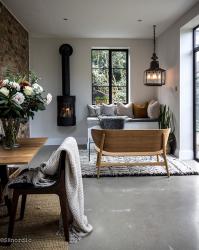Take a breath, take a seat, take a look around. Feel the temperature, smell the air. Consider — even for a moment — where you are.
This feeling, this sense of presence and consciousness and stillness, is hyggeligt. Often translated from Danish to “coziness” or “comfort,” hygge has become the catchall phrase for cashmere socks next to a warm fire, curling up with a cup of tea and a good book or a satisfying meal by intimate candelight. The beauty of hygge is that it can be all of those things. But it is, at it’s origin, much more simple than that. “I’m not an expert on this at all,” laughs Dabney Frake, the projects editor at Apartment Therapy. “My understanding is that a lot of people think it’s footie pajamas on the couch, drinking hot cocoa. For me, I think, it’s supposed to have a little bit more of a mindfulness angle.”
More than soft blankets and warm candles, “conscious coziness,” Frake explains, is about being mindful of all of your senses. “So that you can expand the concept beyond that blanket to inviting people into your home and having really great, meaningful conversation over the dinner table. It doesn’t have to be something you go out and try to buy. It’s a frame of mind as much as it is a décor style.”
Born from Scandinavian sensibilities, hygge — as a design concept — has been translated into everything from food and drinks to 2016’s wave of auburn, honey and chestnut curls crafted by L.A. hairstylists. But as Frake describes, and interior-design firms like Studioilse demonstrate, the reason hygge applies to such a range of media or environments is because of its focus on the atmospheric qualities of a single moment in time. Be that in your home, in your hotel, in your glass or on your head.
“It often gets translated [in the home] as that kind of minimalist, textured style,” Frake expands, “but I think it’s whatever works for you.” The way she sees it, taking hygge home with you is accomplished by bringing in whatever makes your space feel responsive and alive. Whatever makes you feel and take notice that you are truly at home. “I’m a major homebody,” says Frake, “it’s baked into my DNA. So to me, in my own home, when my wife and I were renovating and to instill that sense of coziness, we installed a wood stove. In St. Louis, they’re certainly not necessary, but for me it’s that smell of real wood, being huddled around the warm fire, that scream home.”
With hygge, the look of home falls flat if the feel of home isn’t celebrated and cherished fully. So though warm neutrals, buttery soft fabrics and clean lines may capture the idyllic look of the Danish concept, “it definitely goes beyond that,” Frake says. “And I think that that’s what makes it really beautiful.”







